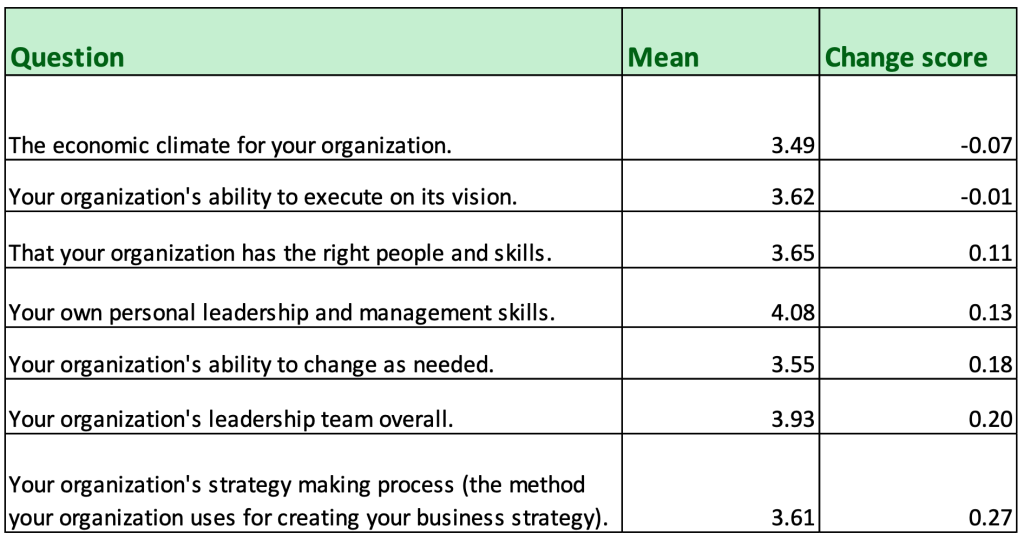What happens when outside forces wreak havoc on a group? In some cases, the group can lose momentum, and in other situations, the group bonds strengthen. In the current pandemic, our data show that employees are retaining confidence in their leaders and their own skills. Even with the onset of the current COVID-19 threat, and its associated financial, emotional, and personal challenges, leaders in organizations that we studied have managed to help employees to the point where individuals are reporting improvements in leadership confidence levels.
The Leadership Confidence Pulse is a set of seven questions that have been tracked annually since 2003. We also have used these items to assess confidence in numerous client organizations. Leadership confidence, in many ways, parallels consumer confidence. When consumers are confident, they buy more. When employees are confident, they are more willing to do more on the job, in particular, more of what is commonly called “above and beyond” behaviors. What that means to us in the research work we have done is that employees spend time focusing not only on the key aspects of their core job but also on four other non-job roles that we have defined and studied. Those are a team member role (doing things to help out your team, even when not part of the core job), an innovator / entrepreneurial role (engaging in the support of and development of new ideas and products / services), a career role (spending time doing things that will help build new skills and enhance an individual’s career), and lastly the organization member role (doing activities that help the company overall, even though it is not part of the core job). These non-core job roles are important when we find ourselves in high-change situations; thus, higher levels of confidence bode well for organizations and leaders.
While we might expect confidence to go down during high-stress times, the data show that for most of the confidence items, the change from last year is positive. See table below (sorted from low to high based on change scores):

The two items that had negative or no change are confidence in economic climate and ability to execute on vision. However, all other items show positive changes from last year. Thus, under conditions of high fear, general instability, and lots of unknowns, respondents are expressing higher confidence in items that have been difficult to change in prior years.
I also do a lot of research on energy and sense of urgency, and we have found in many studies that when a sense of urgency (or fear) comes from the outside, employees and leaders ban together to fight against the threat, and those actions have numerous positive outcomes including improved confidence levels.
Note that in terms of overall mean scores, the highest confidence is attributed to oneself. That is something that we see in most studies, and given the stress so many people are under today, I personally was happy to see that finding. I want individuals to be confident they can thrive in this new environment.
We also track employee energy when we do each Leadership Pulse, and we asked respondents to tell us how their overall confidence levels are affecting their personal energy. Below are some answers to this question:
- “I definitely think that when I have a high level of confidence, I am more energized by what I am doing. When I am less confident That I have the knowledge and abilities to do a certain task, it takes a lot of energy from me to do it.
- Lack of confidence (as a whole) lowers my energy. I need to trust my skilled colleagues to have higher energy.
- Right now, I am executing, so I am riding the confidence bull.
- Lack of confidence zaps energy.
- Major impact. The higher our confidence, the more energy and momentum we have.”
While the data show positive impacts on confidence now, it will be important for leaders to continue to help employees as we all move to new stages of the pandemic fight. For those who go back to the office, they will need to feel confident in their ability to stay healthy. For those who continue working at home, they need assurance that their employers will help with tactical issues and understand that this disruption means most people are not necessarily at their best.
Lastly, I wanted to share some lessons we have learned examining confidence during tough times in the past. We found that, only in high performing firms, did the scores for confidence in my leadership go down compared to confidence in the team overall. In other words, leadership humility grew during challenging times. To this day, I cannot tell you why, but I have some hypotheses.
- Leaders realized it takes more than just ‘the’ leader to perform when challenges go up.
- Leaders quit competing and started cooperating.
In tough times there are not rewards for competition; survival requires high levels of cooperation, caring, and communication – and that drives confidence.
